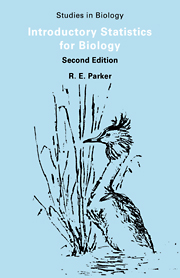Book contents
- Frontmatter
- Contents
- How to use this book
- 1 Probability and Statistics
- 2 Continuous Distributions: Confidence Limits
- 3 Continuous Distributions: Tests of Significance
- 4 Discontinuous Distributions: Binomial Distribution
- 5 Discontinuous Distributions: Poisson Distribution
- 6 Analysis of Frequencies: Single Classification
- 7 Analysis of Frequencies: Double Classification
- 8 Interrelationships of Quantitative Variables
- 9 Analysis of Variance: Single Classification
- 10 Analysis of Variance:Double Classification
- Solutions to Problems
- Further Reading
- Selected Statistical Tables
5 - Discontinuous Distributions: Poisson Distribution
Published online by Cambridge University Press: 05 June 2012
- Frontmatter
- Contents
- How to use this book
- 1 Probability and Statistics
- 2 Continuous Distributions: Confidence Limits
- 3 Continuous Distributions: Tests of Significance
- 4 Discontinuous Distributions: Binomial Distribution
- 5 Discontinuous Distributions: Poisson Distribution
- 6 Analysis of Frequencies: Single Classification
- 7 Analysis of Frequencies: Double Classification
- 8 Interrelationships of Quantitative Variables
- 9 Analysis of Variance: Single Classification
- 10 Analysis of Variance:Double Classification
- Solutions to Problems
- Further Reading
- Selected Statistical Tables
Summary
When do we meet this distribution?
When we count blood cells or microorganisms within a square of a haemocytometer slide or when we count emissions of a radioactive sample within a certain time we are counting randomly-distributed items or events in an unbiassed sample. Such counts have a particular kind of discontinuous distribution in which the probabilities of obtaining a count of a certain size (from 0 upwards) is given by the corresponding term of the Poisson expansion: e-m(1, m, m2/2!, m3/3!, m4/4!. etc.), where m is the mean number of items or events.
Standard error
We have seen how a normal distribution may be defined in terms of its mean and standard deviation, and a binomial distribution in terms of its mean (pn) and number in a group (n). The Poisson distribution is peculiar in that it is completely defined by one parameter, its mean. Not only this, the variance of the counts is equal to their mean, i.e. σ2 = µ. In practice we can make a single count, say X, and use it to estimate both µ and σ2. The S.E. of X as an estimate of µ, is then estimated as √X.
Confidence limits
Like the binomial distribution the Poisson distribution is discontinuous but always to some degree asymmetrical. These features are most marked when m is low, see Fig. 5–1. As m increases so the distribution becomes more nearly symmetrical and, like the binomial, approaches a normal distribution.
- Type
- Chapter
- Information
- Introductory Statistics for Biology , pp. 33 - 37Publisher: Cambridge University PressPrint publication year: 1991



